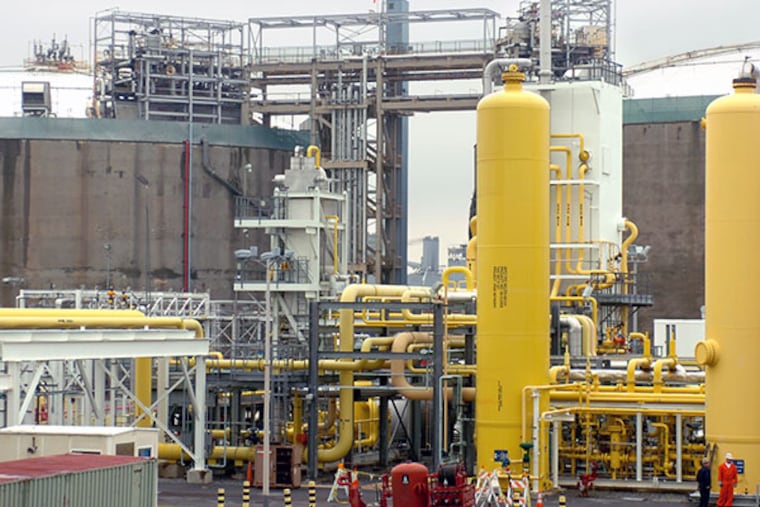Phila. again ponders allure of liquefied natural gas
Despite Philadelphia City Council's "unqualified" rejection nine years ago of a terminal for liquefied natural gas, the city is once again flirting with the money-making allure of LNG.

Despite Philadelphia City Council's "unqualified" rejection nine years ago of a terminal for liquefied natural gas, the city is once again flirting with the money-making allure of LNG.
Several entrepreneurs are promoting plans to increase LNG production at the Philadelphia Gas Works plant in Port Richmond, hoping to capitalize on growing interest in creating an energy hub linked to the Marcellus Shale natural gas boom.
The most ambitious plan floated publicly is a $2.1 billion proposal to expand the Port Richmond plant's capacity to export LNG to European markets.
Penn American Energy L.P. says its plan would generate $150 million a year for PGW, helping the city utility to curb rates, rebuild its aging distribution system, and increase its $18 million annual fee to cash-strapped municipal coffers.
No privatization is involved in its plan, Penn Energy says, avoiding a sensitive issue that doomed Mayor Nutter's proposal last year to sell PGW for $1.86 billion.
City Council now seems eager to demonstrate that it can find an alternative to the $424 million pension-fund infusion Nutter said a PGW sale would have generated.
PGW has produced liquefied natural gas at its Port Richmond plant for more than 40 years to store gas for distribution on the coldest winter days.
LNG is produced by chilling natural gas to minus-260 degrees until it turns into a liquid. When the liquid is warmed, it converts back to gas.
Several partnership proposals are being shopped to city officials, including one by former PGW bidder Liberty Energy Trust, that would expand LNG production at Port Richmond on a smaller scale.
These are aimed not at exports, but at a growing domestic market for LNG as a clean-burning replacement for fuel oil and diesel in trucking, shipping, and remote power-generation applications.
The Penn Energy plan is more ambitious and would generate far more potential revenue for the city, based on the greater volumes of natural gas that would be processed.
The proposal is similar to the 2006 plan to create an LNG terminal at Port Richmond. That proposal was to build an import terminal, not an export terminal. But both plans involve moving large ships containing LNG on the Delaware River, which created queasiness in waterfront neighborhoods in 2006.
"It's not a project we should be considering at all," State Sen. Mike Stack, now the lieutenant governor, said in 2006 after visiting Boston to witness its LNG traffic.
City Council rejected the plan in 2006 by a 12-2 vote in a nonbinding resolution declaring its "unqualified opposition to any project that would create an LNG shipping terminal within the City of Philadelphia."
Some Council members now seem more receptive.
Councilman David Oh, who was not a member in 2006, expressed disbelief at a recent hearing that the city turned away Penn Energy's initial approach in 2012 to build an export terminal because the Nutter administration had set course to sell the utility.
"I have a great interest that we at least explore this and put this on the table to voters," Oh said at the March 13 hearing.
The 2006 plan was derailed for a host of reasons, including public uproar over the perceived dangers of shipping LNG.
There is no shortage of complications that could trip up a revived plan to build an export terminal, which would attract substantial activist opposition this time because exports would boost demand for hydraulically fractured shale gas.
An export terminal would need upgraded pipelines to deliver up to 700 million cubic feet of gas a day to the LNG plant. The Tioga Marine Terminal would need to be relocated to accommodate LNG vessels. And the major bridges linking this area with New Jersey might be closed during the departure of LNG vessels.
"There are challenges across the board," acknowledged Franc James, 52, a Philadelphia native who heads Penn Energy. "But to generate $150 million in revenue for the city, there are going to be challenges. It's not an easy project."
A very large hurdle would be obtaining a license to export LNG. The Department of Energy has approved nine of 35 applications to export LNG to non-Free Trade Agreement countries, which make up the biggest market for the fuel. Most industry observers believe only a fraction of the projects will be built because the export market can absorb only so much LNG.
Philip Rinaldi, chief executive of Philadelphia Energy Solutions' South Philadelphia oil-refinery complex, belittled the LNG export business at the recent Council hearing, calling it an "extremely expensive" way to chase international markets.
"I think that's a crazy business, I have to tell you," Rinaldi said.
James, the head of Penn Energy, was introduced to the energy industry via an unorthodox route. He was a partner in India with a firm exporting iron ore when Indian public officials enlisted him to help find supplies from the American shale-gas boom.
He formed the Indo America Energy Group in 2012 to export LNG to India. The company was reborn as Penn America after his Indian partners found other LNG supplies.
"Franc is an eclectic guy, well-connected," said James Seif, a principal at Ridge Global, the risk-management consulting firm founded by former Gov. Tom Ridge that is working with Penn Energy.
James hopes the Penn Energy proposal would leapfrog other projects awaiting export licenses because of its municipal support and because of national-security interests - its target market would be European nations held hostage by Russian natural gas supplies.
"Our view is that the merits of this project differentiate it from other projects in the queue," he said.
But first, the city has to sign on, a challenge with the mayor in his final year in office and Council still exploring a range of PGW options.
"We don't have anything unless we have the city," James said.